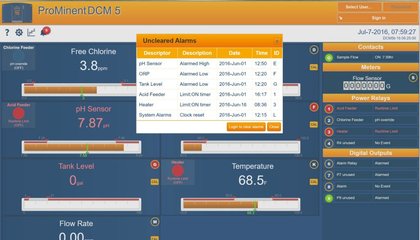Find Out What That Blinking Light Means On Your Controller

Tuesday, January 12, 2021
Who among you has ever noticed that blinking red alarm light on your controller? When this happens, do you simply clear it and continue with your day? Or do you stop, learn as many details as you can, and figure out how to prevent it from occurring again?
For context, let’s look at the situation from a different perspective. Pretend you’re driving down the road, and your check engine light comes on. What do you do? Do you figure out how to clear it and keep driving? Probably not. You likely take it to a mechanic to diagnose and correct the problem.
In visits with clients, I’ve seen many people observe their controller in alarm and not bat an eye. We’ll talk for 20-plus minutes, and they never notice the blinking red light. (It’s driving me crazy wondering what is the problem and why.)
When a controller’s alarm light blinks, it should be a surprise — not a constant that you go blind to. You need to understand the alarm, what caused it and why. Let’s review some of the more common causes of alarms, what they mean, and what can be done to prevent their recurrence.
STOP THE NUISANCE
The most commonly ignored alarms are what I would call “nuisance alarms.” These are activated based on parameters that you weren’t even interested in monitoring or controlling.
Controllers can do a lot of things — and not every aquatics facility needs to use every function. But that doesn’t prevent the related alarm from activating if the parameters don’t fall within the settings. For instance, the reading for the Langelier Saturation Index (LSI) often requires the operator to manually input some numbers. A lot of people don’t take time to do this, which can affect other readings and throw the controller in alarm.
This also includes alarms that just aren’t set up correctly for the operation practices of your pool. These parameters alarm frequently even though everything is just as you intended. Say you do want to manage the temperature. If you want your pool at 74 degrees, you can put a high at 76 and a low of, say, 70. But you don’t want to set the alarm at 74, because there will be fluctuations.
Another example: When sample flow alarms activate daily due to auto-backwash events or regenerative filter bump. By just making a slight adjustment to the alarm — allowing the sensors to lose flow for a longer period of time — you can keep it from going off every time you backwash.
An unfortunate result comes when a controller frequently lets off an inconsequential alarm: The operator becomes numb to the blinking red light and either stops clearing it or automatically clears it without investigating the cause. All the operator needs to do is take a few minutes, understand the alarm, and adjust the settings so it only alarms when something is actually wrong. I see this scenario so frequently that I often remind operators to review and adjust settings as needed.
REAL CAUSE FOR ALARMS
Now that you’re anxious to adjust all of your alarm parameters properly, let’s look at an example and possible solutions to have better control of that parameter — and fewer alarms — going forward.
Your chemical controller likely reads at least two of the following: pH, ORP, PPM, TDS, etc. Most controllers can be programmed with low and high alarm points set related to each of these readings. If these high/low alarms are triggered, what caused them?
Some things to check: Are the high/low alarms set too close to your set point? Is the sensor reading accurately or does it need calibrating? If it reads accurately, what caused the value to run outside its acceptable range? Did the feeder run out of chemical or malfunction? Or do you need to make adjustments to the control parameters (set point, run time, proportional control, etc.), or adjust the chemical feeder itself so it doesn’t cause overshooting/undershooting the set point?
It’s easy enough to figure out if you get a low-chlorine alarm and you’ve run out of chlorine. But other times, it can take a bit more digging to find the cause. It could require trial and error in adjusting settings on the controller, feeder or both. You may need to turn down the feeder, get a different sized feeder or implement other solutions.
GO TO THE SOURCE
For specifics on other types of alarms and what they could mean, I’d like to refer you to my favorite acronym: RTFM — Read the Free Manual. You can find a lot of good information to help you better understand the equipment you have, how to set it up and how to make it work for you!
If you still have questions after reading your manual, be sure to contact your pool equipment supplier or manufacturer for further assistance. Before calling, prepare some vital information that will help the vendor, such as what kind of alarm it is, chemical readings and other vital stats related to the alarm. If somebody calls to say they have a chlorine alarm, I’d ask for the actual chlorine reading and sensor reading. It’s also good to know the pH and alkalinity levels, and the temperature. The manufacturer’s technical support may ask for other readings, but those will get you through quite a few questions.
WORTH THE WHILE
I know it can seem like a lot, but taking the time to methodically search for the root cause and work to minimize the possibility of recurrence will help you to run a safer, more efficient pool. That way when an alarm does occur, you’ll be properly “alarmed” by it, react constructively, and work to find a meaningful resolution quickly.